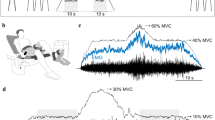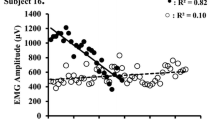Summary
The effects of pre-motion silent period (PSP) on dynamic force exertion were studied in ten healthy subjects performing ballistic elbow extensions. The experiments were designed to evaluate the significance of mean differences between the averaged dynamic force curves of two groups: PSP-presence groups and PSP-absence groups. The presence of PSP was judged quantitatively and automatically by means of a newly developed method using statistical analysis. The results indicated that there were two effects of PSP on dynamic force exertion: one was a reducing effect, observed prior to the movement; the other was a reinforcing effect, observed in the first part of the ballistic movement. The duration of the reinforcement was significantly correlated with the duration of the reducing effect of PSP. The findings suggested that the reinforcement of dynamic force may be produced by the pre-stretch of agonistic muscles caused by prior force reduction due to PSP occurrence. The fact that PSP plays an important role in dynamic force exertion suggests that PSP may be incorporated in the central motor control system designed to interrupt the background activity, to stretch the agonist and to reinforce the dynamic force.
Similar content being viewed by others
References
Asumussen A, Bonde-Petersen F (1974) Apparent efficiency and storage of elastic energy in human muscle during exercise. Acta Physiol Scand 92:537–545
Cavagna GA (1970) Elastic bounce of the body. J Appl Physiol 29:279–282
Cavagna GA, Dusman B, Margaria B (1968) Positive work done by a previously stretched muscle. J Appl Physiol 24:21–32
Conrad R, Benecke R, Goehmann M (1983) Premovement silent period in fast movement initiation. Exp Brain Res 51:310–313
Cowan MA, Day BL, Marsden C, Rothwell JC (1986) The effect of percutaneous motor cortex stimulation on H reflexes in muscles of the arm and leg in intact man. J Physiol 377:333–347
Evarts EV, Fromm C (1978) The pyramidal tract neuron as summing point in a close-loop control system in the monkey. In: Desmedt JE (ed) Cerebral motor control in man. Progress in clinical neurophysiology. Karger, Basel, pp 56–69
Ikai M (1955) Inhibition as an accompaniment of rapid voluntary act (in Japanese). Nippon Seirigaku Zasshi 17:292–298
Jankowska E, Tanaka R (1974) Neuronal mechanism of the disynaptic inhibition evoked in primate spinal motoneurones from the corticospinal tract. Brain Res 75:163–166
Komi PV, Bosco C (1978) Utilization of stored elastic energy in leg extensor muscles by men and women. Med Sci Sports 10:261–265
Lance JW, Burke D, Andrews CJ (1973) The reflex effects on muscle vibration. In: Desmedt JE (ed) New developments in electromyography and clinical neurophysiology. Karger, Basel, pp 444–462
Mita K, Aoki H, Tsukahara R, Yabe K (1985) Statistical properties of electromyogram during sustained contraction (in Japanese). Jpn J Phys Educ 30:55–63
Mortimer JA, Eisenberg P, Palmer S (1987) Premovement silence in agonist muscles preceding maximum efforts. Exp Neurol 98:542–554
Preston JB, Whitlock DG (1960) Precentral facilitation and inhibition of spinal motoneurons. J Neurophysiol 23:154–170
Thys H, Faraggiana T, Margaria R (1972) Utilization of muscle elasticity in exercise. J Appl Physiol 32:491–494
Usui S, Amidror I (1982) Digital low-pass differentiation for biological signal processing. IEEE Trans Biomed Eng BME-29:686–693
Yabe K (1976a) Premotion silent period in rapid voluntary movement. J Appl Physiol 41:470–473
Yabe K (1976b) Electromyographic silent period preceding a rapid voluntary movement. In: Komi PV (ed) Biomechanics V-A. University Park Press, Baltimore, pp 75–81
Yabe K (1984) Temporal depression of EMG activity prior to a rapid voluntary movement in normal and handicapped subjects. In: Kumamoto M (ed) Neural and mechanical control of movement. Yamaguchi Shoten, Kyoto, pp 52–59
Yabe K, Aoki H, Mita K (1978a) Premotion silence observed in the contralateral limb. In: Asumussen E, Jorgensen K (eds) Biomechanics VI-E. University Park Press, Baltimore, pp 148–152
Yabe K, Mita K, Aoki H (1978b) Inhibitory phenomenon prior to the rapid voluntary movement in healthy and handicapped subjects. In: Landry F, Orban WAR (eds) Biomechanics of sports and kinanthropometry. Symposia Specialists, Miami, pp 85–90
Author information
Authors and Affiliations
Rights and permissions
About this article
Cite this article
Aoki, H., Tsukahara, R. & Yabe, K. Effects of pre-motion electromyographic silent period on dynamic force exertion during a rapid ballistic movement in man. Europ. J. Appl. Physiol. 58, 426–432 (1989). https://doi.org/10.1007/BF00643520
Accepted:
Issue Date:
DOI: https://doi.org/10.1007/BF00643520




